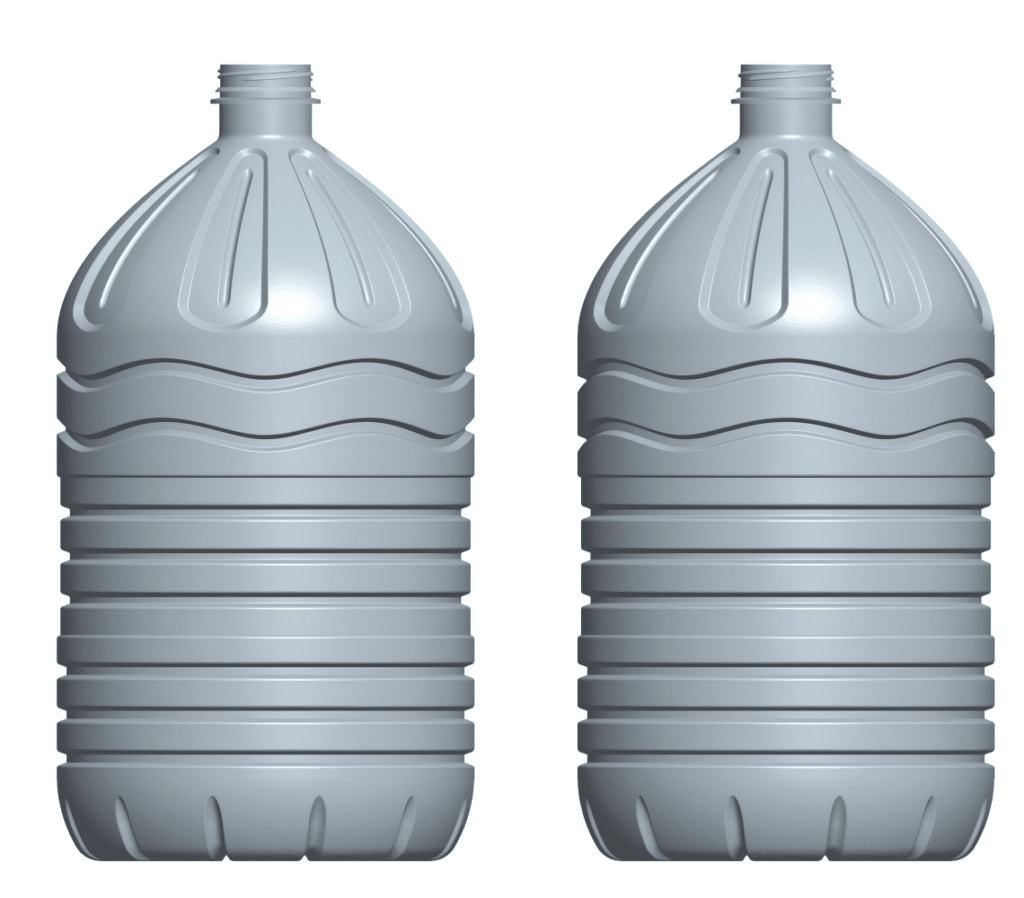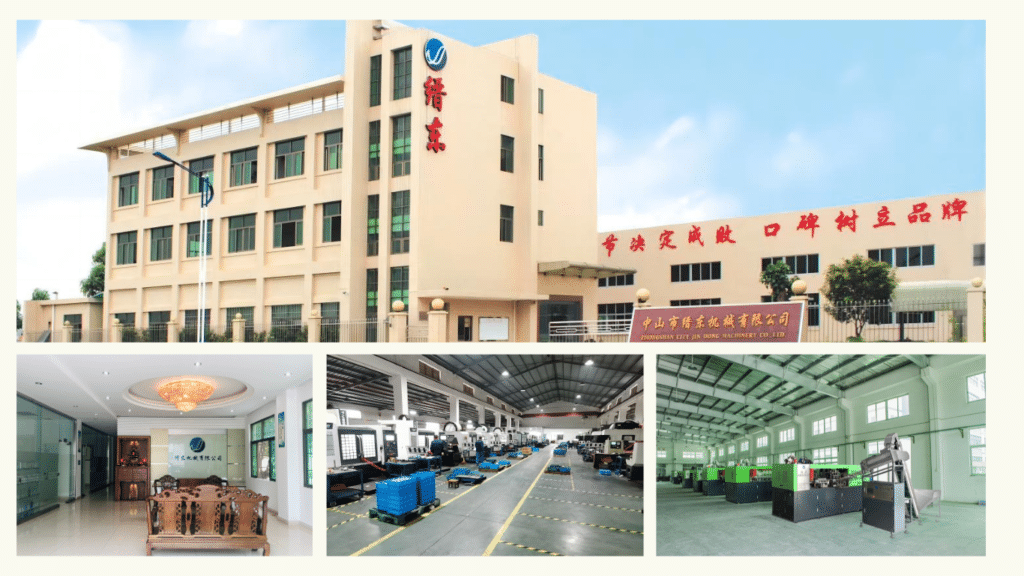Struggling with the high costs and hygiene risks of reusable PC water gallons? It's time to consider a modern, more efficient alternative that is taking over the market.
The primary reason 15L single-use PET bottles are replacing traditional PC gallons is due to significantly lower production costs, superior hygiene standards, and greater consumer convenience. This shift eliminates the expensive and complex processes of collecting, sterilizing, and refilling old PC gallons, driving rapid market adoption.
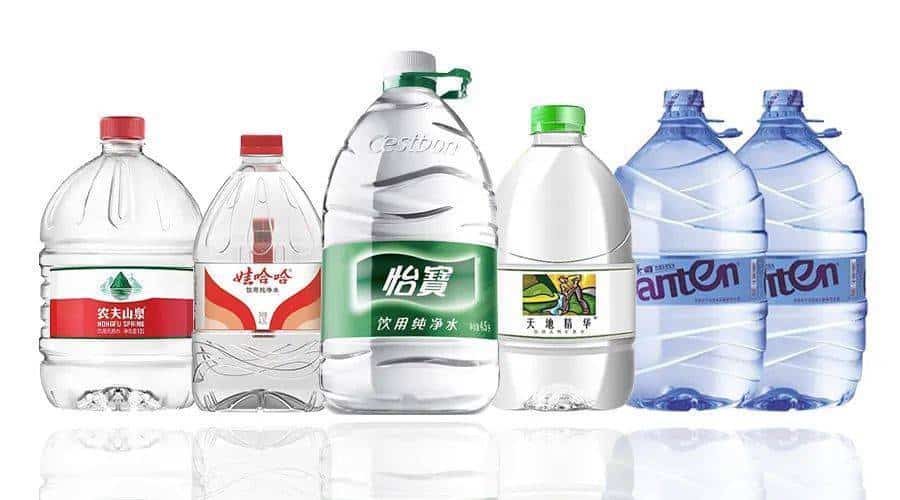
This change isn't just a minor trend; it's a fundamental transformation in the bottled water industry. As consumers become more health-conscious and businesses look for more sustainable and cost-effective solutions, the advantages of PET become impossible to ignore. I've seen this firsthand with my clients, who are making the switch and seeing immediate benefits. Let's explore exactly why this is happening and what it means for producers.
Market Shift: Why Are 15L PET Buckets Gaining Popularity Over PC Gallons?
Worried about the growing expenses and logistical headaches of your reusable PC water gallon business? You're not alone in seeking a better way forward in a competitive market.
The market is rapidly moving toward 15L PET bottles because they offer a winning combination of lower costs, guaranteed hygiene, and unmatched consumer convenience. The heavy financial burden of sanitizing and recovering PC gallons is the main force pushing producers toward single-use PET solutions.
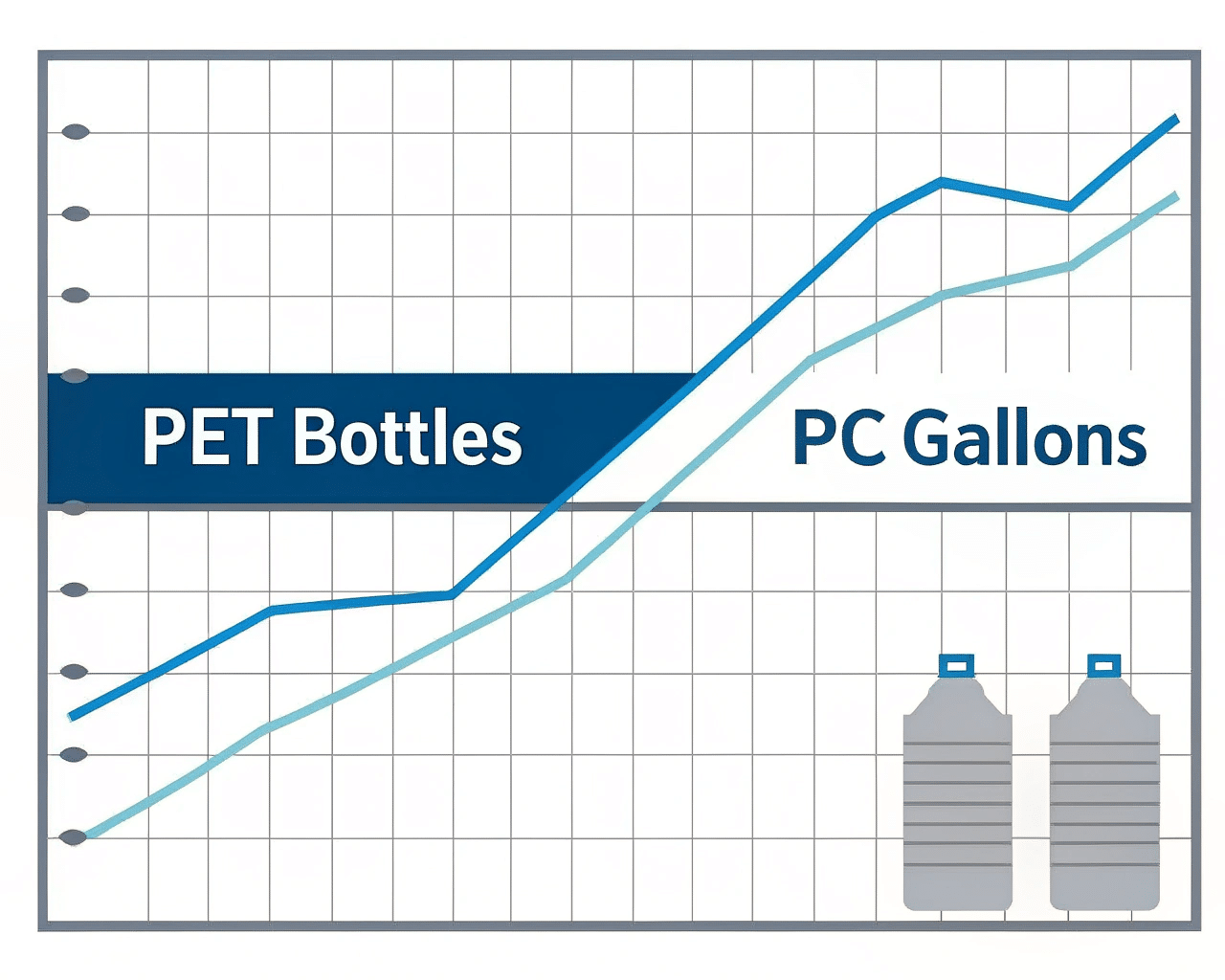
I've witnessed this transformation directly. For example, a client of mine in Thailand ran a large factory for 18.9L PC gallons for years. He faced constantly rising costs for recovering, cleaning, and inspecting the reusable gallons. Last year, he decided to launch a 15L single-use PET bottle line. The new product was an instant success. It has already replaced 40% of his old reusable gallon market, and that number continues to grow this year. The key drivers for this success are clear:
Cost Efficiency
The production cost of a single-use PET bottle is significantly lower than the lifecycle cost of a reusable PC gallon. PC gallons require a robust reverse logistics system for collection, intensive multi-step washing and sterilization processes, and manual inspection for cracks or contamination, all of which add significant operational expenses.
Hygiene and Safety
Consumers today are more concerned about health than ever. Single-use PET bottles provide peace of mind, as each bottle is brand new and clean. PC gallons, even with proper cleaning, can harbor residual contaminants or develop micro-cracks over time that are difficult to detect, posing a potential health risk.
Consumer Convenience
PET bottles are lighter than their PC counterparts, making them easier for consumers to handle and place on water dispensers. Their crystal-clear appearance also allows users to easily see the water level, which is a small but significant preference. This trend is especially strong in emerging markets across Southeast Asia and the Middle East, where new production lines are overwhelmingly choosing PET.
| Feature | Reusable PC Gallons | Single-Use 15L PET Bottles |
|---|---|---|
| Initial Cost | High | Low |
| Lifecycle Cost | High (Collection, Cleaning, Sterilization) | Low (Production Only) |
| Hygiene | Risk of contamination over time | Guaranteed sterile |
| Logistics | Complex reverse logistics required | Simple one-way distribution |
| Consumer Appeal | Heavy, can look worn | Lightweight, always new and clear |
What Are the Structural Benefits of PET Blow Molding for Large Buckets?
Are you concerned that large water bottles might get damaged or collapse during transport and stacking? This is a valid fear that can lead to significant product loss and customer dissatisfaction.
PET bottles are created using a blow molding process that forms the entire structure in one seamless piece, making them inherently stronger and more resistant to pressure. With features like a reinforced bottom and tailored wall thickness, their stability during shipping and stacking is vastly improved.
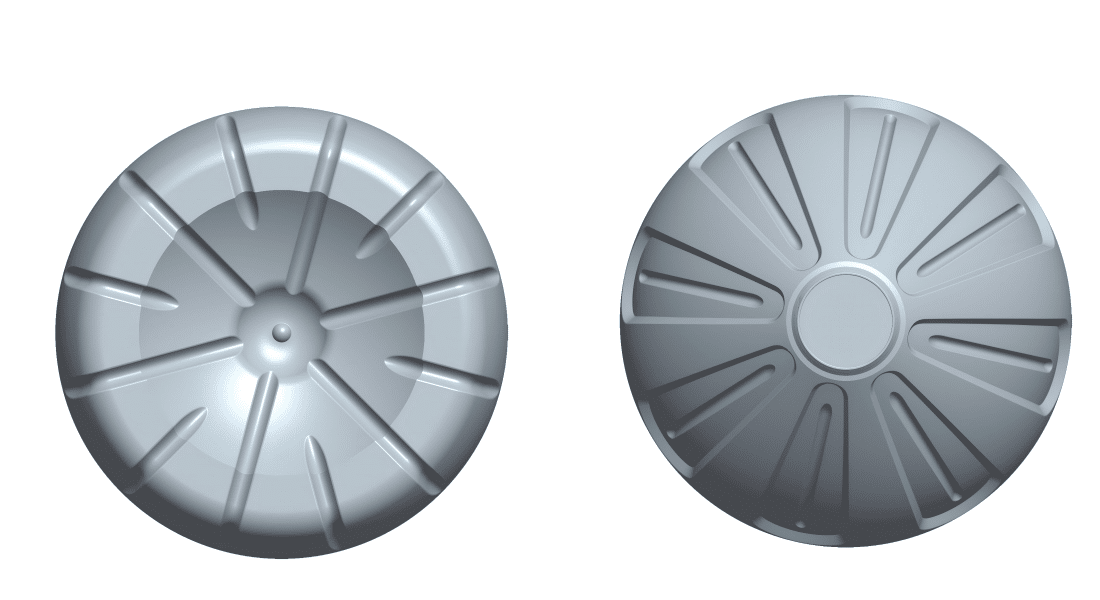
When producing large-capacity containers like a 15L bottle, structural integrity is not just a feature; it's a necessity. The single-body construction achieved through a quality blow bottle mold is a major advantage over other materials that may involve multiple parts or seams, which can become points of weakness. Here’s a deeper look at the specific design elements that make PET the superior choice for large bottles:
One-Piece Formation
The PET blow molding process starts with a preform that is heated and stretched into its final shape inside a mold. This means there are no seams or joints. The resulting bottle is a single, continuous piece of plastic, which distributes stress evenly across its surface. This monolithic structure is naturally more resistant to impacts and the high pressure that comes from stacking bottles multiple layers high.
Reinforced and Optimized Design
Engineers can precisely control the material distribution during the blowing process. This allows for thicker walls in high-stress areas and a specially designed reinforced base. These rib structures on the bottom and sides prevent the bottle from bulging under pressure or collapsing when handled, which is a common problem my clients face before we optimize their design.
Consumer-Friendly Transparency
The inherent clarity of PET is another structural benefit. It isn't just about aesthetics; it allows both the producer and the end consumer to visually inspect the water quality and monitor the remaining water level easily. This transparency builds trust and adds to the user's convenience.
How to Choose the Right Neck Finish: 45mm vs 55mm and Usage Impact?
Are you unsure whether a 45mm or 55mm neck finish is the correct choice for your new 15L PET water bottle line? This decision directly impacts your bottle's compatibility and production setup.
For broad compatibility, the 55mm neck finish is the recommended standard as it fits most water dispensers and existing capping systems. The smaller 45mm neck is a suitable option for applications where the bottle will be used with kettles or portable pumps.
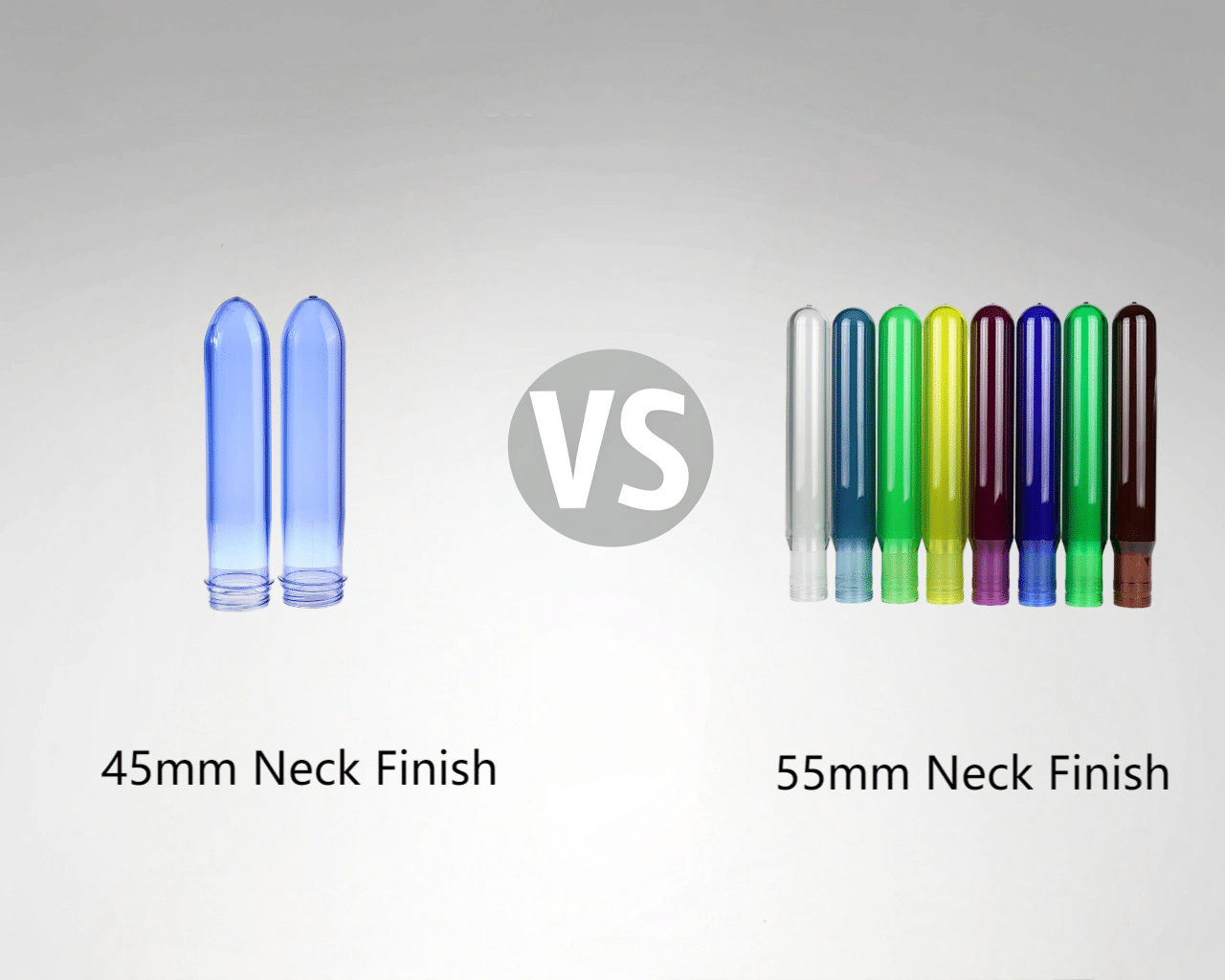
Choosing the neck finish is a critical decision that must be made early in the design process. It affects everything from the preform mold design to the capping machine on your filling line. The choice between 45mm and 55mm depends entirely on your target market and intended use.
The 55mm Standard
The 55mm neck has become the de facto standard for large water cooler bottles. Its primary advantage is its universal compatibility.
- Dispenser Fit: It is designed to fit snugly and securely on the vast majority of commercial and household water coolers.
- Cap System: It works seamlessly with the widely available 5-gallon snap-on caps, which are trusted by the industry for providing a reliable seal.
For any business aiming to replace traditional PC gallons, I almost always recommend the 55mm neck to ensure a smooth transition for the end-users who already own dispensers.
Niche Applications for 45mm
The 45mm neck finish offers a more compact and sometimes more cost-effective solution, but its applications are more specific.
- Portability: It is often paired with a screw cap and a built-in handle, making the bottle easier to carry and pour from directly.
- Direct Use: This size is ideal for households or offices that do not use a standard dispenser but pour water into smaller pitchers or electric kettles.
Your choice will require customized components for your bottle blowing machine, including the mold neck cavity and the grippers that handle the bottles, so it’s a decision that impacts the entire production line.
| Neck Finish | Primary Use Case | Recommended Cap | Production Impact |
|---|---|---|---|
| 55mm | Standard Water Dispensers/Coolers | Snap-on Cap | Ensures compatibility with existing market hardware |
| 45mm | Direct Pouring, Portable Pumps | Screw Cap | Requires custom handling parts, less universal |
How Should a Bottle Shape Be Designed for Transport to Prevent Deformation?
Are you constantly dealing with the financial losses and customer headaches caused by bottles that get dented, creased, or deformed during shipping and handling?
A robust bottle design that incorporates strategic reinforcing ribs on the sides and base is essential. The entire shape must be engineered within the blow bottle mold to withstand the immense pressures of long-distance container shipping and warehouse stacking.
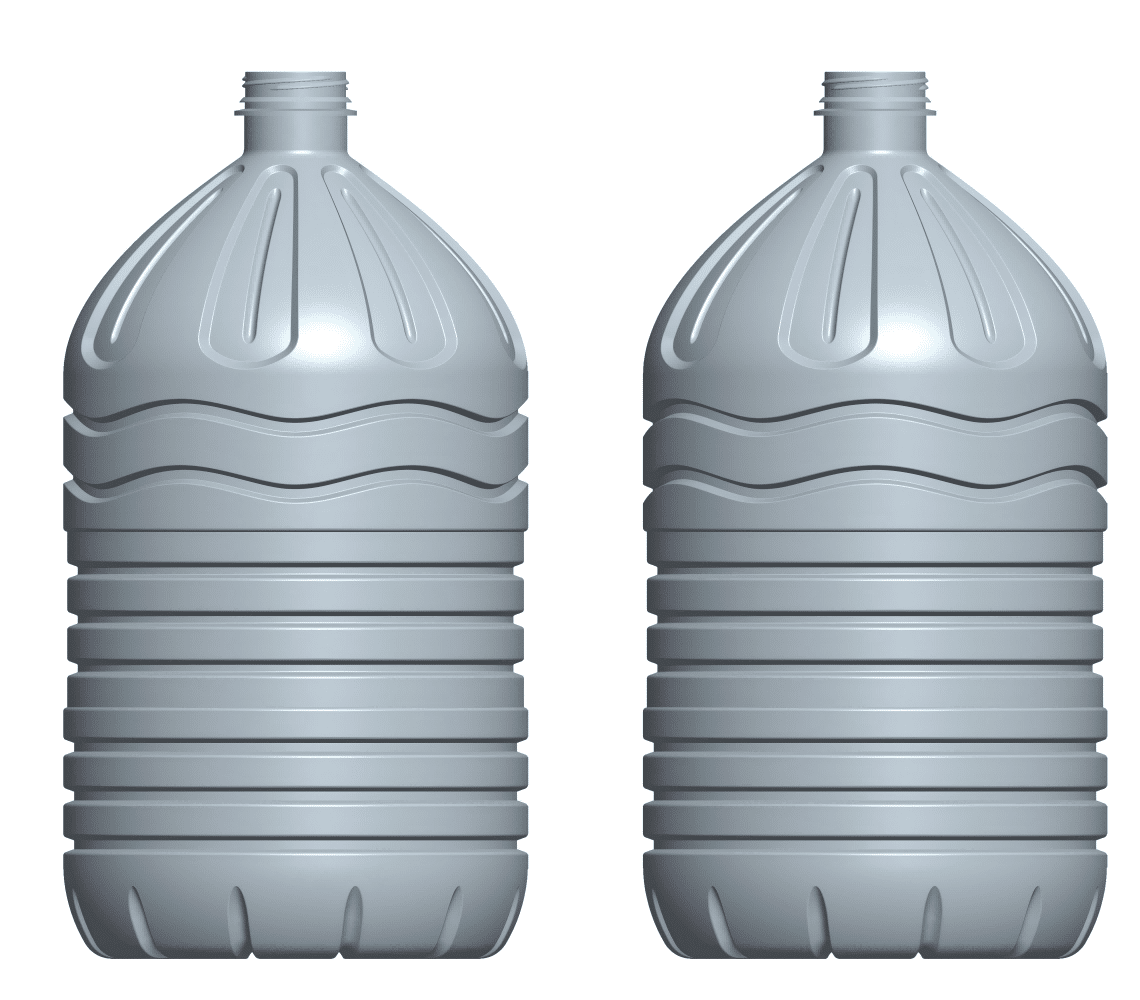
This is one of the biggest pain points I hear from clients. A bottle can look perfect coming off the production line, but it's worthless if it can't survive the journey to the customer. This is where thoughtful design, informed by real-world experience, makes all the difference. I encountered this exact issue with my Thai client. Initially, he wanted his new 15L PET bottle to have the same shape as his old 18.9L PC gallons to maintain brand familiarity.
I had to explain that PET and PC are fundamentally different materials. Copying the old PC design would require an extremely heavy PET preform, which would drive up his costs significantly and still not guarantee stability. Instead, I persuaded him to let my team design a new bottle shape specifically for PET.
Strategic Reinforcement
We focused on adding subtle yet strong reinforcing ribs (or "筋" in Chinese) to the design.
- Bottom Ribs: The design of the base is the most critical element. We created a multi-footed base with deep ribs that act like pillars, preventing the dreaded "鼓底" (bottom bulge) when bottles are stacked.
- Side Ribs: Horizontal or vertical ribs along the bottle's sidewall prevent it from wrinkling or collapsing under side pressure, which often happens during loading and unloading.
Optimizing for a Full Pallet
We didn't just design a bottle; we designed a bottle that works as part of a system. The shape was optimized so that the bottles nestle together securely on a pallet. This creates a stable, interlocked block of product that is much more resistant to shifting and toppling during container transport from Asia to other markets. The new design was quickly accepted by his customers and has virtually eliminated his losses from transport damage.
Which Works Best for PET 15L Containers: Screw vs Snap-on Caps?
Are you debating between a screw cap and a snap-on cap for your 15L PET bottles? The choice seems simple, but it has a big impact on leak prevention and user convenience.
Screw caps provide a more secure, airtight seal, making them the superior choice for preventing leaks, especially when bottles are transported horizontally. Snap-on caps are easier for users to apply and remove but require higher precision from the mold and capping machine.
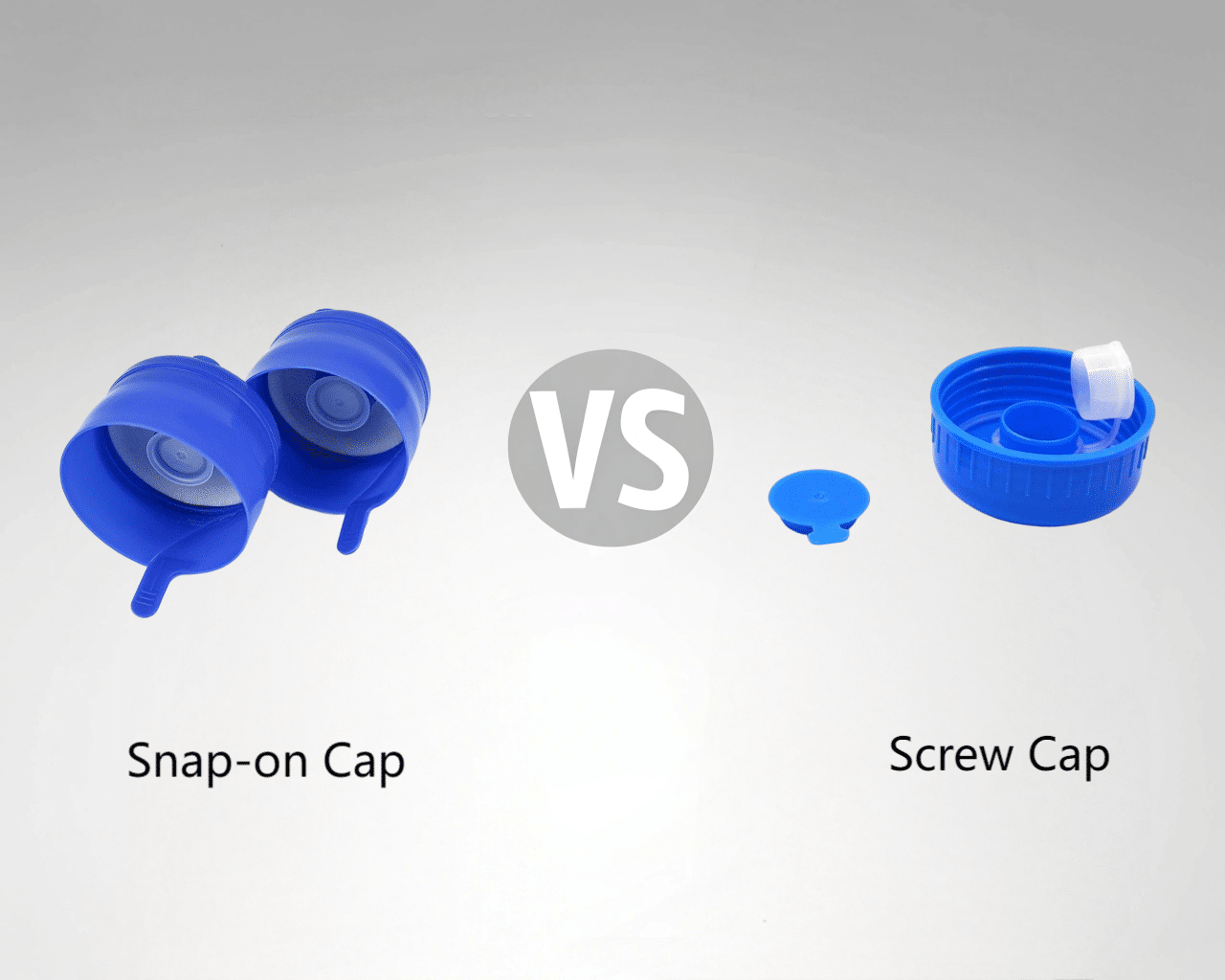
The right cap is the final touchpoint that ensures your product reaches the customer in perfect condition and is easy for them to use. The decision between a screw-on (螺旋盖) or snap-on (卡口盖) cap should be based on your distribution model and your primary end-user.
The Security of a Screw Cap
A screw cap, often used with a 45mm neck finish, creates a seal through torque.
- Leak Prevention: The threads provide a tight, continuous seal that is highly resistant to loosening from vibrations during transport. This is critical for home delivery services where bottles might be laid on their side in a vehicle.
- Tamper-Evident: Most screw caps can easily incorporate a tamper-evident ring that breaks upon first opening, giving consumers confidence in the product's integrity.
The main drawback is that they can be slightly more difficult for some users to unscrew and are not compatible with standard water coolers without an adapter.
The Convenience of a Snap-on Cap
A snap-on cap, the standard for the 55mm neck finish, seals by fitting tightly over and inside the bottle's neck.
- Ease of Use: These caps are designed for convenience. They can be pushed on by hand or machine and are easily pierced by the probe on a water dispenser. Users don't need to unscrew anything; they just place the bottle on the cooler.
- High Precision Required: The trade-off for this convenience is that the seal is entirely dependent on the precise dimensions of both the bottle neck and the cap. A high-quality blow bottle mold and a well-calibrated capping machine are absolutely essential to prevent leaks.
Ultimately, if your primary sales channel is through standard water dispensers in homes and offices, the 55mm neck with a snap-on cap is the industry standard. For more portable or direct-pour uses, a screw cap is often the better choice.
What Are the Key Blow Molding Considerations for Large PET Bottles?
Are you ready to start producing 15L PET bottles but feel overwhelmed by the technical machine specifications you'll need? Getting the equipment right is crucial for stable, efficient production.
For medium-scale production (200-300 BPH), I recommend a semi-automatic bottle blowing machine. For high-volume needs, a fully automatic machine is better. The machine must have customized heating units for large preforms, a reinforced clamping frame, and an optimized air and cooling system.
Blowing a small 500ml bottle is very different from blowing a large 15L container. The larger size requires more precision, power, and cooling to achieve a stable and consistent result. You can't just use a standard machine; it needs to be adapted for the specific challenges of large-bottle production.
Specialized Machine Configuration
Here are the essential customizations I discuss with every client starting a 15L project:
- Customized Heating Oven: Large preforms (for example, 350g or more) need longer and more intensive heating. The machine's heating oven must have additional heating lamps and a longer tunnel to ensure the preform reaches the ideal, uniform temperature before blowing.
- Reinforced Mold Clamping Frame: The blowing pressure required for a 15L bottle is immense. The machine's clamping unit must be incredibly strong and rigid to hold the two halves of the heavy blow bottle mold shut without any flex. Any movement can result in an inconsistent bottle shape or a dangerous failure.
- Optimized Air and Cooling: Large bottles require a high volume of high-pressure air delivered quickly. The machine's air-path configuration, including pipes and valves, must be sized accordingly. Furthermore, the mold itself needs an optimized water-cooling channel layout to remove heat efficiently, which is key to maintaining a fast cycle time and ensuring the bottle holds its shape after being ejected.
| Machine Component | Standard Bottle Machine | Required for 15L Bottle Machine | Reason for Upgrade |
|---|---|---|---|
| Heating Oven | Standard length and lamps | Longer oven, more heating lamps | To evenly heat large, thick preforms |
| Clamping Unit | Standard frame | Reinforced, high-tonnage frame | To withstand higher blowing pressure |
| Air System | Standard valves and pipes | High-flow valves, wider pipes | To fill the large bottle volume quickly |
| Mold Cooling | Standard channels | Optimized, multi-zone cooling | To solidify the thick walls and reduce cycle time |
Production Efficiency: Should You Choose Semi-Auto or Fully Auto for 15L Bottles?
Are you trying to decide between a lower-cost semi-automatic machine and a high-output fully automatic line for your 15L bottle production? This choice depends entirely on your budget and production goals.
Semi-automatic equipment offers a lower initial investment and great flexibility, making it perfect for startups, smaller batches, or OEM manufacturing. A fully automatic linear machine is better for factories producing over 3,000 bottles per day due to its high speed and efficiency.
Choosing the right level of automation is one of the most important investment decisions you will make. It directly affects your capital expenditure, labor costs, and production capacity. I always advise my clients to look at their business plan for the next 3-5 years before deciding.
The Flexibility of Semi-Automatic Machines
A semi-automatic bottle blowing machine requires an operator to manually place the heated preforms into the blowing station.
- Lower Investment: The initial cost is significantly less than a fully automatic system, making it an accessible entry point for new businesses or those testing the market.
- Flexibility: It's much faster and easier to change molds on a semi-auto machine. This is ideal if you produce multiple bottle shapes or sizes in smaller quantities.
- Ideal Use Case: Perfect for production volumes between 200 and 300 bottles per hour (BPH). It's a great starting point for many businesses.
The Power of Fully Automatic Machines
A fully automatic machine handles the entire process, from loading preforms to ejecting finished bottles, without human intervention.
- High Capacity: These machines, especially linear models, can easily produce 1000-1200 BPH or more, making them suitable for large-scale operations with established demand.
- Consistency and Lower Labor Costs: Automation reduces the chance of human error, leading to more consistent bottle quality. It also significantly lowers your per-bottle labor cost.
- Rotary (High-End): For massive, centralized production facilities, rotary blow molding machines offer the highest speeds and efficiency, but they also represent the largest investment. They are best for major national brands.
| Machine Type | Initial Investment | Output Capacity (BPH) | Flexibility | Best For |
|---|---|---|---|---|
| Semi-Automatic | Low | 200 - 300 | High | Startups, OEM, Small Batches |
| Fully Auto (Linear) | Medium - High | 1000 - 1200 | Medium | Daily production >3000 bottles |
| Fully Auto (Rotary) | Very High | 2000+ | Low | Large, centralized beverage companies |
Our PET 15L Solution: How Can We Provide Custom Molds, Blow Machines and Full Line Support?
Are you looking for a single, experienced partner to guide you through every step of setting up a successful 15L PET bottle production line?
We provide a complete, turn-key custom PET 15L water bottle solution. Our service covers everything from custom mold design and machine selection to full production line support, ensuring you get a stable and efficient system tailored to your specific needs.
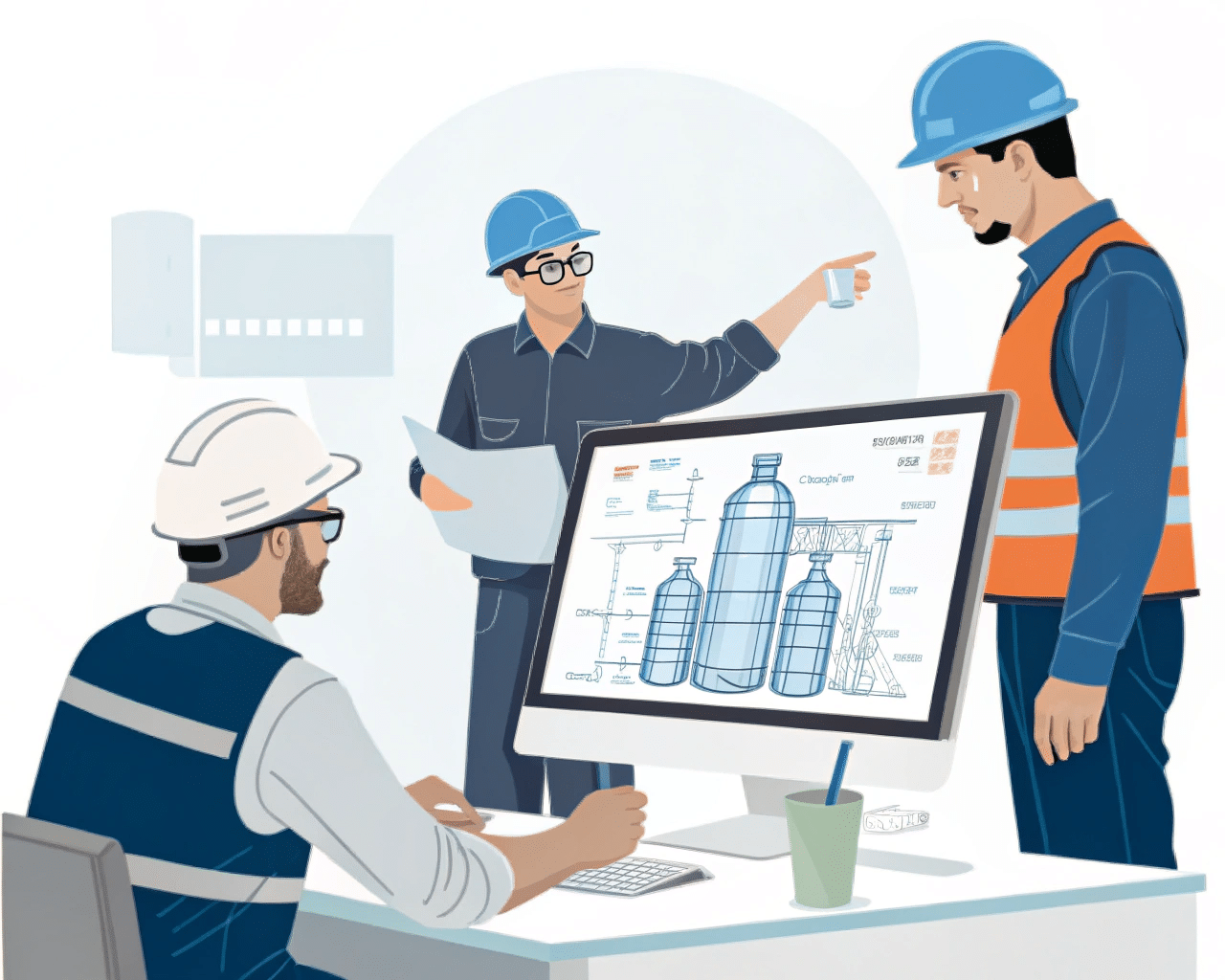
Embarking on a new production project can be complex, but you don't have to do it alone. My team and I specialize in providing comprehensive project support built on years of hands-on experience. We don't just sell machines; we deliver complete, working solutions. We act as your technical partner to ensure your investment is successful from day one.
Our full-service approach includes:
- Custom Design and Prototyping: We start with your vision. We help you choose the right neck finish (45mm or 55mm) and then design a bottle and blow bottle mold with optimized reinforcement for transport stability. We can provide 3D drawings and physical samples for testing before you commit to the final tooling.
- Machine and Equipment Recommendation: Based on your target capacity and budget, we recommend the ideal bottle blowing machine, whether it's a flexible semi-automatic model or a high-capacity fully automatic line. We also help you select all the necessary auxiliary equipment, like air compressors and water chillers.
- Integrated Line Support: We provide expert advice on everything from your preform mold and cap selection to how the new blowing machine will integrate with your existing or planned filling and packaging lines. Our goal is to ensure a seamless workflow.
- PET Bottle Mold Support: We stand behind our tooling. Our PET bottle mold support ensures that your molds are delivered on time and perform to specification, providing consistent, high-quality bottles from the very first run.
After finalizing the technical plan, we provide a clear assessment of the project delivery timeline, including installation and on-site commissioning to get your line up and running smoothly.
Conclusion
The shift from PC gallons to 15L PET bottles is a clear win for cost, hygiene, and efficiency. This modern solution meets today's market demands for safer, more convenient bottled water.
Frequently Asked Questions (FAQ)
1. How does the cost of a 15L PET bottle system compare to a PC gallon system?
While the initial investment for a PET blowing line can be significant, the overall long-term cost is much lower. You eliminate the huge operational expenses of collecting, washing, sterilizing, and tracking a fleet of reusable PC gallons. The per-bottle production cost for single-use PET is a fraction of the lifecycle cost of a PC gallon.
2. Can I use my old 18.9L PC gallon design for a new 15L PET bottle to keep my brand look?
I strongly advise against this. As I explained to my client in Thailand, PET and PC are different materials with different structural properties. A design made for rigid PC will not be stable if made from PET without making it extremely heavy and expensive. It's much better to create a new, optimized design for PET that is both strong and cost-effective.
3. What is the minimum production volume needed to justify a fully automatic line?
A good rule of thumb is if your daily production demand is consistently above 3,000-4,000 bottles, a fully automatic linear machine becomes a very sensible investment. The savings in labor costs and the increase in production consistency and speed will provide a clear return on the higher initial investment.
4. How do you guarantee the 15L PET bottles won't leak during transport?
Leak prevention comes from a combination of three factors: a well-designed bottle neck, a high-quality cap, and a precisely manufactured blow bottle mold. For snap-on caps, the dimensional accuracy of the neck is critical. For screw caps, the thread design and proper application torque are key. We ensure all these elements work together perfectly.
5. What is the typical project lead time for a complete 15L PET bottle production line?
The lead time can vary based on the level of customization and the type of machinery (semi-auto vs. fully auto). Typically, from final design approval to a complete line being ready for commissioning, a project can take anywhere from 3 to 6 months. This includes mold manufacturing, machine assembly, and testing.
🔗 Learn More about Bottled Water Types and Sustainability
-
Bottled Water – Wikipedia
Provides a general overview of bottled water, including packaging types such as single-use PET and large returnable containers. -
Reusable Packaging – Wikipedia
Explains the concept of packaging designed for multiple uses, relevant to returnable 5-gallon water bottles.
🔗 Related Pages on Our Website
-
Automatic Blow Molding Machines – iBottler
Discover our full range of automatic blow molding solutions for PET bottles. -
Semi-Automatic Blow Molding Machines – iBottler
Ideal solutions for startups and small-scale PET bottle production.
